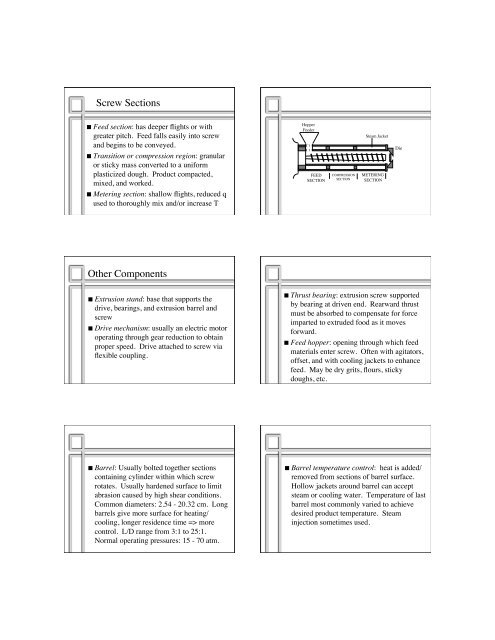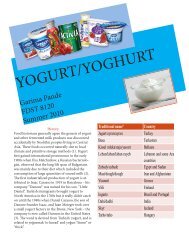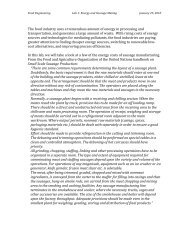You also want an ePaper? Increase the reach of your titles
YUMPU automatically turns print PDFs into web optimized ePapers that Google loves.
Screw Sections<br />
Feed section: has deeper flights or with<br />
greater pitch. Feed falls easily into screw<br />
and begins to be conveyed.<br />
Transition or compression region: granular<br />
or sticky mass converted to a uniform<br />
plasticized dough. Product compacted,<br />
mixed, and worked.<br />
Metering section: shallow flights, reduced q<br />
used to thoroughly mix and/or increase T<br />
Other Components<br />
Extrusion stand: base that supports the<br />
drive, bearings, and extrusion barrel and<br />
screw<br />
Drive mechanism: usually an electric motor<br />
operating through gear reduction to obtain<br />
proper speed. Drive attached to screw via<br />
flexible coupling.<br />
Barrel: Usually bolted together sections<br />
containing cylinder within which screw<br />
rotates. Usually hardened surface to limit<br />
abrasion caused by high shear conditions.<br />
Common diameters: 2.54 - 20.32 cm. Long<br />
barrels give more surface for heating/<br />
cooling, longer residence time => more<br />
control. L/D range from 3:1 to 25:1.<br />
Normal operating pressures: 15 - 70 atm.<br />
Hopper<br />
Feeder<br />
FEED<br />
SECTION<br />
COMPRESSION<br />
SECTION<br />
Steam Jacket<br />
METERING<br />
SECTION<br />
Thrust bearing: extrusion screw supported<br />
by bearing at driven end. Rearward thrust<br />
must be absorbed to compensate for force<br />
imparted to extruded food as it moves<br />
forward.<br />
Feed hopper: opening through which feed<br />
materials enter screw. Often with agitators,<br />
offset, and with cooling jackets to enhance<br />
feed. May be dry grits, flours, sticky<br />
doughs, etc.<br />
Barrel temperature control: heat is added/<br />
removed from sections of barrel surface.<br />
Hollow jackets around barrel can accept<br />
steam or cooling water. Temperature of last<br />
barrel most commonly varied to achieve<br />
desired product temperature. Steam<br />
injection sometimes used.<br />
Die





